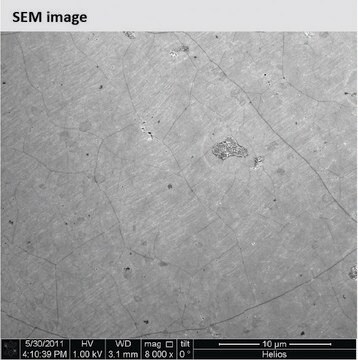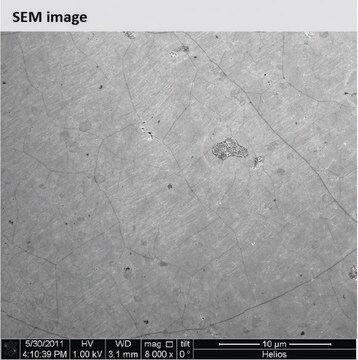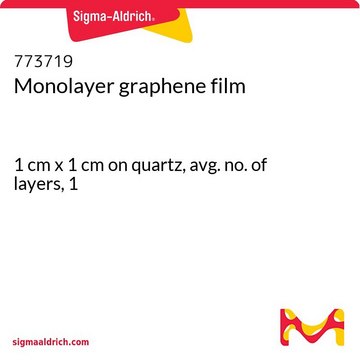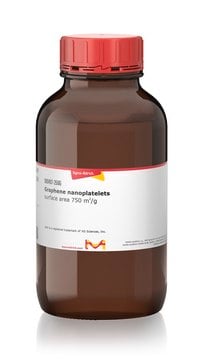GRTRANSFER25
Graphene, monolayer film
Easy transfer, L × W 1 in. × 1 in.
About This Item
Prodotti consigliati
Nome del prodotto
Easy transfer monolayer Graphene, L × W 1 in. × 1 in., avg. no. of layers, 1
Caratteristiche
avg. no. of layers 1
Modalità di accrescimento
CVD
Resistenza foglio
450 +/- 40 Ω/sq, on SiO2/Si (1cm x 1cm)
Lungh. × largh.
1 in. × 1 in.
Copertura della superficie
>98%
Colore
transparent>97%
Dimensione grani
≤20 μm
Cerchi prodotti simili? Visita Guida al confronto tra prodotti
Categorie correlate
Descrizione generale
Structure of the easy-transfer graphene:
Top sacrificial layer (square shaped), CVD monolayer graphene in the middle, and bottom water-releasable polymer support layer (round shaped)
Applicazioni
This product employs a specially designed mechanism for easy and clean transfer of high quality monolayer CVD grown graphene to build state-of-art electronic devices such as:
- Graphene based state-of-art FET
- Graphene based sensors
- Heterostructure based micro/nano electronics
Clean tranfer can be done following below 3 easy steps:
Release
Put the sample on deionized(DI) water slowly, round side (polymer layer) facing down, the square-shaped sacrificial layer+graphene will gradually detach from the rorund polymer film. Once the sacrificial layer/graphene is floating remove the round polymer film.
Transfer
Bring the desired substrate into the same DI water container while the sacrificial layer/graphene is floating. Tilt the substrate 45º and bring it into contact with the sacrificial layer/graphene from below. Take the sacrificial layer/graphene/substrate out and let it dry for 30 minutes in air. Then anneal the samples on a hot plate at 150 Celsius for 1h. Finally, before removing the sacrificial layer, store it under vacuum for at least 24h to avoid detachment of the graphene from your substrate.
Sacrificial layer Removal
To remove the sacrificial layer two methods can be used:
Solvents: Dip the sacrificial layer/graphene/substrate in acetone for 1h, then into isopropyl alcohol for another 1h and blow the sample with N2 to dry it.
Thermal treatment: Put the sacrificial layer/graphene/substrate into an oven and heat the sample at 450 C in
inert atmosphere for 2h.
Codice della classe di stoccaggio
11 - Combustible Solids
Classe di pericolosità dell'acqua (WGK)
WGK 1
Punto d’infiammabilità (°F)
Not applicable
Punto d’infiammabilità (°C)
Not applicable
Scegli una delle versioni più recenti:
Certificati d'analisi (COA)
It looks like we've run into a problem, but you can still download Certificates of Analysis from our Documenti section.
Se ti serve aiuto, non esitare a contattarci Servizio Clienti
Possiedi già questo prodotto?
I documenti relativi ai prodotti acquistati recentemente sono disponibili nell’Archivio dei documenti.
Articoli
Dr. Xiang’s and Maruyama’s review presents the most recent research activities on 1D vdWHs, including the candidate materials, the synthetic techniques, and characterization methods. The optoelectronic applications are discussed in detail for different constructions of the 1D vdWHs-based devices (FETs, sensors, LEDs, photovoltaic devices, and light detection). Some challenges and perspectives for future development and applications of 1D vdWHs are also proposed to conclude the review.
Il team dei nostri ricercatori vanta grande esperienza in tutte le aree della ricerca quali Life Science, scienza dei materiali, sintesi chimica, cromatografia, discipline analitiche, ecc..
Contatta l'Assistenza Tecnica.








